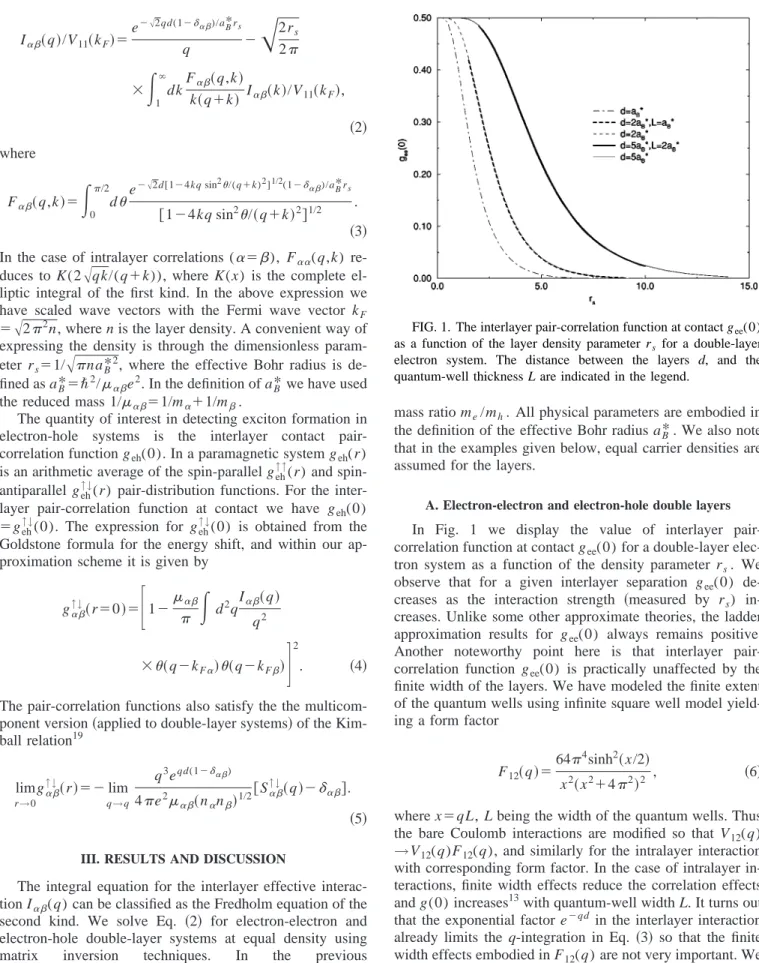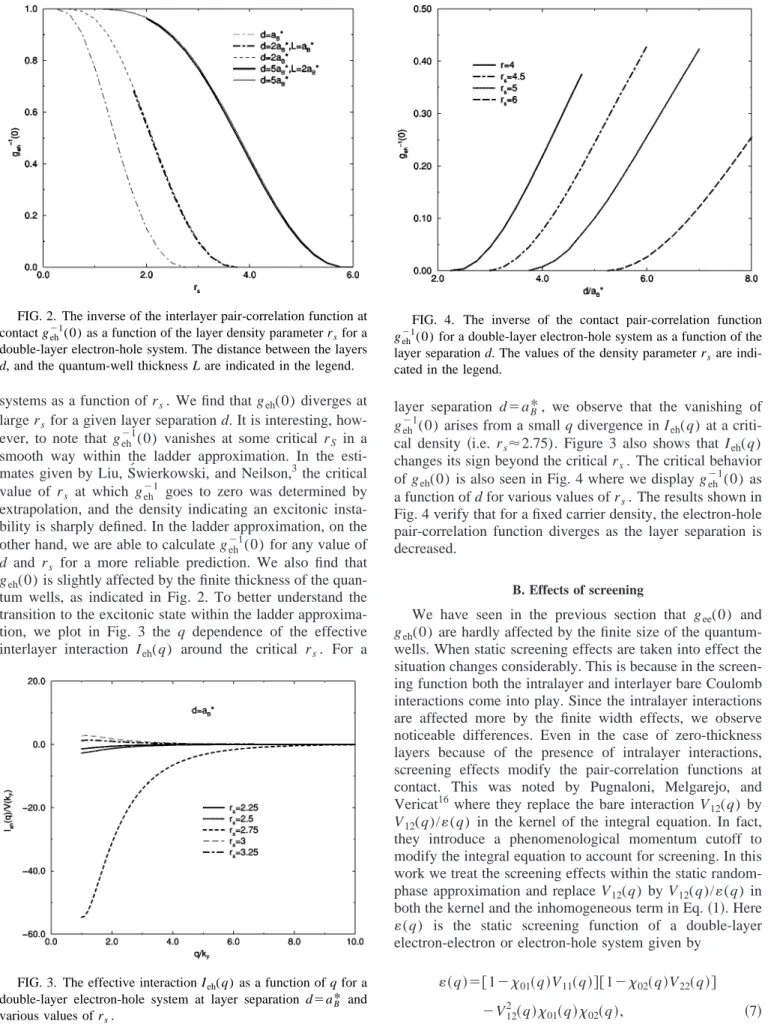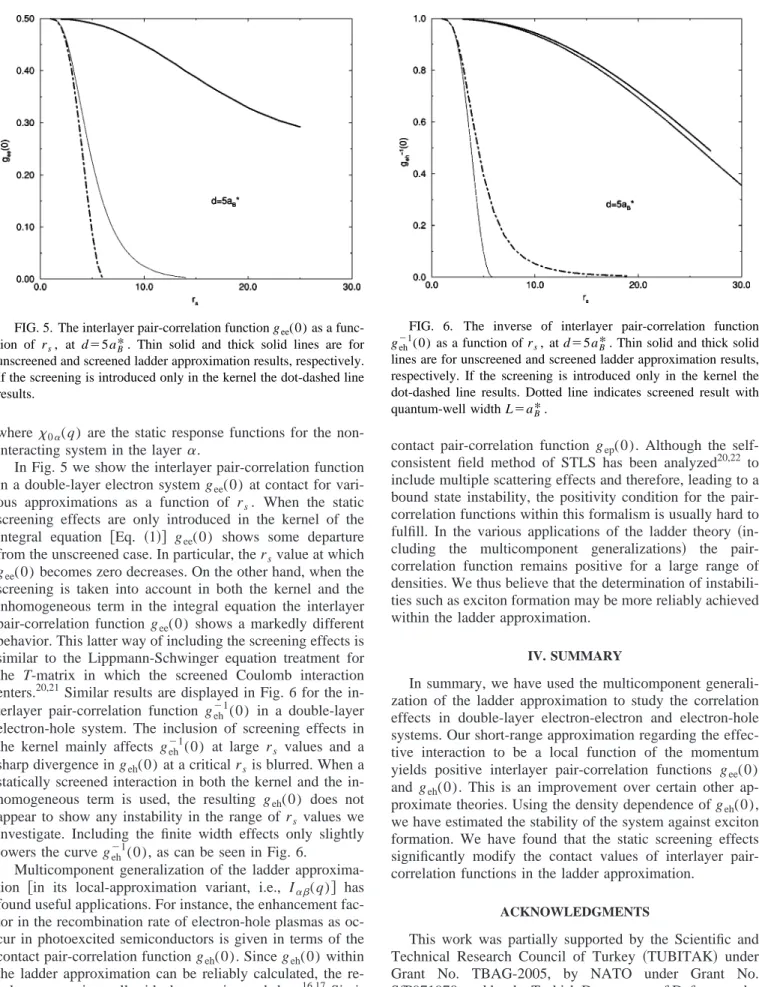Ladder approximation in coupled quantum-well systems
A. Yurtsever and B. TanatarDepartment of Physics, Bilkent University, Bilkent, 06533 Ankara, Turkey 共Received 18 October 2000; published 12 March 2001兲
We study the contact values of the interlayer pair-correlation function in electron-electron and electron-hole double-layer systems. For this purpose the ladder approximation as generalized to multicomponent systems is used. The ladder approximation yields positive values for the interlayer gee(0) and geh(0) for all values of the
density parameter rs and layer spacing d. This allows us to infer possible instabilities in the system more reliably compared to other approaches. We also investigate the effects of quantum-well width and screening on the interlayer pair-correlation functions.
DOI: 10.1103/PhysRevB.63.125320 PACS number共s兲: 73.63.Hs, 05.30.Fk, 71.45.Gm
I. INTRODUCTION
Double-layer electron-electron and electron-hole systems are under extensive theoretical and experimental study in re-cent years.1 Advances in growth techniques in semiconduc-tors have led to the detailed investigations of multilayer structures. It is generally believed that in these systems the effects of interparticle interactions are enhanced because of reduced dimensionality and an extra degree of freedom pro-vided by the layer index. Study of manybody effects2in low-dimensional electronic systems, thus, became amenable to experimental observations.
In this work we apply the ladder theory to double-layer electron-electron and electron-hole systems. Our broad aim is to see how the effective interactions treated within the ladder approximation compare with other theoretical ap-proaches, such as the self-consistent field approach. In par-ticular, we are motivated by the recent work of Liu, S´wierkowski, and Neilson3 who studied the exciton forma-tion in spatially separated electron-hole liquids based on the Singwi, Tosi, Land, and Sjo¨lander共STLS兲 formalism.4It has been known that the self-consistent field method of STLS applied to multicomponent systems yields pair-correlation functions that are at quantitative and qualitative variance with other theoretical approaches.5,6Therefore, our aim is to study the interlayer pair-correlation functions at contact gee(0) and geh(0) for electron-electron and electron-hole double-layer systems.
The ladder approximation was introduced for the purpose of studying the pair-correlation function in electron gas systems.7 There has been many detailed studies in a variety of contexts and dimensionalities making use of the particle-particle ladder vertex function in the past.8–13 Freeman14 studied the correlation energy and antiparallel spin pair-correlation function of the two-dimensional electron gas within the particle-particle approximation of the coupled-cluster equations making contact to the ladder approxima-tion. Recently, an extension of the ladder theory to multi-component systems were given in a series of papers by Vericat and Melgarejo,15 Pugnaloni, Melgarejo, and Vericat16and Melgarejo et al.17in connection with photoex-cited electron-hole systems in quantum wells and quantum wires. We employ the multicomponent generalization of the ladder theory in application to double-layer electron-electron
and electron-hole systems and particularly calculate the con-tact values of the pair-correlation function for these systems. The divergence in the interlayer geh(0) may be used to un-derstand the excitonic instability building in a spatially sepa-rated electron-hole system.
The rest of this paper is organized as follows. In Sec. II we introduce the formalism of ladder approximation for double-layer systems. In Sec. III we present our results for electron-electron and electron-hole double-layers consider-ing also the effects of screenconsider-ing. Our results are discussed in relation to other theoretical approaches in the same section. Finally, we conclude with a brief summary in Sec. IV.
II. MODEL AND THEORY
We choose a simple model of double-layer system in the form of a pair of quantum-wells separated by an infinite bar-rier. The intra- and inter-layer Coulomb interactions are given by V␣(q)⫽2e2e⫺qd(1⫺␦␣)/(⑀
0q), in which⑀0 is the background dielectric constant, ␣,⫽1,2 are the layer indices, and d is the distance between the quantum wells. The effective interaction between two charge carriers within the ladder approximation is given by
I␣共k1,k2;q兲⫽V␣共q兲⫹
兺
k V␣共q⫺k兲 ⫻关1⫺ f␣共k1⫹k兲兴关1⫺ f共k2⫺k兲兴 ⑀k1,␣⫺⑀k1⫹k,␣⫹⑀k2,⫺⑀k2⫺k, ⫻I␣共k1,k2;k兲, 共1兲where f␣(k) is the zero-temperature Fermi distribution func-tion and ⑀k,␣⫽k2/2m␣ is the single-particle energy for
spe-cies␣. When the short-range correlations are assumed to be most important, we can neglect the dependence of I␣(k1,k2;q) on k1 and k2, and consider I␣(q) ⫽I␣(0,0;q), which is a large momentum transfer q
ap-proximation. Such an approximation was shown to be rea-sonable by full numerical solutions10,18of the integral equa-tion given in Eq. 共1兲. Within this short-range approximation and for a double-layer system, the above integral equation simplifies to
I␣共q兲/V11共kF兲⫽ e⫺冑2qd(1⫺␦␣)/aB*rs q ⫺
冑
2rs 2 ⫻冕
1 ⬁ dkF␣共q,k兲 k共q⫹k兲 I␣共k兲/V11共kF兲, 共2兲 where F␣共q,k兲⫽冕
0 /2 de ⫺冑2d[1⫺4kq sin2/(q⫹k)2]1/2(1⫺␦ ␣)/aB*rs 关1⫺4kq sin2/共q⫹k兲2兴1/2 . 共3兲 In the case of intralayer correlations (␣⫽), F␣␣(q,k) re-duces to K(2冑
qk/(q⫹k)), where K(x) is the complete el-liptic integral of the first kind. In the above expression we have scaled wave vectors with the Fermi wave vector kF⫽
冑
22n, where n is the layer density. A convenient way of expressing the density is through the dimensionless param-eter rs⫽1/冑
naB*2, where the effective Bohr radius is de-fined as aB*⫽ប2/
␣e2. In the definition of aB*we have used
the reduced mass 1/␣⫽1/m␣⫹1/m.
The quantity of interest in detecting exciton formation in electron-hole systems is the interlayer contact pair-correlation function geh(0). In a paramagnetic system geh(r) is an arithmetic average of the spin-parallel geh↑↑(r) and spin-antiparallel geh↑↓(r) pair-distribution functions. For the inter-layer pair-correlation function at contact we have geh(0) ⫽geh↑↓(0). The expression for geh↑↓(0) is obtained from the Goldstone formula for the energy shift, and within our ap-proximation scheme it is given by
g␣↑↓共r⫽0兲⫽
冋
1⫺␣ 冕
d2q I␣共q兲 q2 ⫻共q⫺kF␣兲共q⫺kF兲册
2 . 共4兲The pair-correlation functions also satisfy the the multicom-ponent version共applied to double-layer systems兲 of the Kim-ball relation19 lim r→0 g␣↑↓共r兲⫽⫺ lim q→q q3eqd(1⫺␦␣) 4e2 ␣共n␣n兲1/2关S␣ ↑↓共q兲⫺␦ ␣兴. 共5兲
III. RESULTS AND DISCUSSION
The integral equation for the interlayer effective interac-tion I␣(q) can be classified as the Fredholm equation of the second kind. We solve Eq. 共2兲 for electron-electron and electron-hole double-layer systems at equal density using matrix inversion techniques. In the previous applications7,10,16the bare Coulomb interaction appearing in the kernel was further approximated to obtain an analytical solution to the integral equation. Using the scaled quantities, our results will appear as independent of the electron-hole
mass ratio me/mh. All physical parameters are embodied in
the definition of the effective Bohr radius aB*. We also note that in the examples given below, equal carrier densities are assumed for the layers.
A. Electron-electron and electron-hole double layers
In Fig. 1 we display the value of interlayer pair-correlation function at contact gee(0) for a double-layer elec-tron system as a function of the density parameter rs. We observe that for a given interlayer separation gee(0) de-creases as the interaction strength 共measured by rs) in-creases. Unlike some other approximate theories, the ladder approximation results for gee(0) always remains positive. Another noteworthy point here is that interlayer pair-correlation function gee(0) is practically unaffected by the finite width of the layers. We have modeled the finite extent of the quantum wells using infinite square well model yield-ing a form factor
F12共q兲⫽64
4sinh2共x/2兲
x2共x2⫹42兲2 , 共6兲 where x⫽qL, L being the width of the quantum wells. Thus the bare Coulomb interactions are modified so that V12(q)
→V12(q)F12(q), and similarly for the intralayer interaction with corresponding form factor. In the case of intralayer in-teractions, finite width effects reduce the correlation effects and g(0) increases13with quantum-well width L. It turns out that the exponential factor e⫺qd in the interlayer interaction already limits the q-integration in Eq. 共3兲 so that the finite width effects embodied in F12(q) are not very important. We shall see below that the situation somewhat changes when screening effects are considered.
Figure 2 shows the inverse of interlayer pair-correlation function at contact geh⫺1(0), for double-layer electron-hole
FIG. 1. The interlayer pair-correlation function at contact gee(0)
as a function of the layer density parameter rsfor a double-layer
electron system. The distance between the layers d, and the quantum-well thickness L are indicated in the legend.
systems as a function of rs. We find that geh(0) diverges at large rsfor a given layer separation d. It is interesting,
how-ever, to note that geh⫺1(0) vanishes at some critical rS in a smooth way within the ladder approximation. In the esti-mates given by Liu, S´wierkowski, and Neilson,3the critical value of rs at which geh⫺1 goes to zero was determined by extrapolation, and the density indicating an excitonic insta-bility is sharply defined. In the ladder approximation, on the other hand, we are able to calculate geh⫺1(0) for any value of d and rs for a more reliable prediction. We also find that
geh(0) is slightly affected by the finite thickness of the quan-tum wells, as indicated in Fig. 2. To better understand the transition to the excitonic state within the ladder approxima-tion, we plot in Fig. 3 the q dependence of the effective interlayer interaction Ieh(q) around the critical rs. For a
layer separation d⫽aB*, we observe that the vanishing of geh⫺1(0) arises from a small q divergence in Ieh(q) at a criti-cal density 共i.e. rs⬇2.75). Figure 3 also shows that Ieh(q) changes its sign beyond the critical rs. The critical behavior
of geh(0) is also seen in Fig. 4 where we display geh⫺1(0) as a function of d for various values of rs. The results shown in
Fig. 4 verify that for a fixed carrier density, the electron-hole pair-correlation function diverges as the layer separation is decreased.
B. Effects of screening
We have seen in the previous section that gee(0) and geh(0) are hardly affected by the finite size of the quantum-wells. When static screening effects are taken into effect the situation changes considerably. This is because in the screen-ing function both the intralayer and interlayer bare Coulomb interactions come into play. Since the intralayer interactions are affected more by the finite width effects, we observe noticeable differences. Even in the case of zero-thickness layers because of the presence of intralayer interactions, screening effects modify the pair-correlation functions at contact. This was noted by Pugnaloni, Melgarejo, and Vericat16where they replace the bare interaction V12(q) by V12(q)/(q) in the kernel of the integral equation. In fact, they introduce a phenomenological momentum cutoff to modify the integral equation to account for screening. In this work we treat the screening effects within the static random-phase approximation and replace V12(q) by V12(q)/(q) in both the kernel and the inhomogeneous term in Eq.共1兲. Here (q) is the static screening function of a double-layer electron-electron or electron-hole system given by
共q兲⫽关1⫺01共q兲V11共q兲兴关1⫺02共q兲V22共q兲兴 ⫺V12
2共q兲
01共q兲02共q兲, 共7兲
FIG. 2. The inverse of the interlayer pair-correlation function at contact geh⫺1(0) as a function of the layer density parameter rsfor a
double-layer electron-hole system. The distance between the layers
d, and the quantum-well thickness L are indicated in the legend.
FIG. 3. The effective interaction Ieh(q) as a function of q for a
double-layer electron-hole system at layer separation d⫽aB* and
various values of rs.
FIG. 4. The inverse of the contact pair-correlation function
geh⫺1(0) for a double-layer electron-hole system as a function of the
layer separation d. The values of the density parameter rsare
where0␣(q) are the static response functions for the non-interacting system in the layer ␣.
In Fig. 5 we show the interlayer pair-correlation function in a double-layer electron system gee(0) at contact for vari-ous approximations as a function of rs. When the static
screening effects are only introduced in the kernel of the integral equation 关Eq. 共1兲兴 gee(0) shows some departure from the unscreened case. In particular, the rsvalue at which gee(0) becomes zero decreases. On the other hand, when the screening is taken into account in both the kernel and the inhomogeneous term in the integral equation the interlayer pair-correlation function gee(0) shows a markedly different behavior. This latter way of including the screening effects is similar to the Lippmann-Schwinger equation treatment for the T-matrix in which the screened Coulomb interaction enters.20,21Similar results are displayed in Fig. 6 for the in-terlayer pair-correlation function geh⫺1(0) in a double-layer electron-hole system. The inclusion of screening effects in the kernel mainly affects geh⫺1(0) at large rs values and a
sharp divergence in geh(0) at a critical rsis blurred. When a
statically screened interaction in both the kernel and the in-homogeneous term is used, the resulting geh(0) does not appear to show any instability in the range of rs values we
investigate. Including the finite width effects only slightly lowers the curve geh⫺1(0), as can be seen in Fig. 6.
Multicomponent generalization of the ladder approxima-tion 关in its local-approximation variant, i.e., I␣(q)兴 has found useful applications. For instance, the enhancement fac-tor in the recombination rate of electron-hole plasmas as oc-cur in photoexcited semiconductors is given in terms of the contact pair-correlation function geh(0). Since geh(0) within the ladder approximation can be reliably calculated, the re-sults agree quite well with the experimental data.16,17 Simi-larly, the annihilation rate of positrons in an electron-positron two-component plasma is proportional to the
contact pair-correlation function gep(0). Although the self-consistent field method of STLS has been analyzed20,22 to include multiple scattering effects and therefore, leading to a bound state instability, the positivity condition for the pair-correlation functions within this formalism is usually hard to fulfill. In the various applications of the ladder theory 共in-cluding the multicomponent generalizations兲 the pair-correlation function remains positive for a large range of densities. We thus believe that the determination of instabili-ties such as exciton formation may be more reliably achieved within the ladder approximation.
IV. SUMMARY
In summary, we have used the multicomponent generali-zation of the ladder approximation to study the correlation effects in double-layer electron-electron and electron-hole systems. Our short-range approximation regarding the effec-tive interaction to be a local function of the momentum yields positive interlayer pair-correlation functions gee(0) and geh(0). This is an improvement over certain other ap-proximate theories. Using the density dependence of geh(0), we have estimated the stability of the system against exciton formation. We have found that the static screening effects significantly modify the contact values of interlayer pair-correlation functions in the ladder approximation.
ACKNOWLEDGMENTS
This work was partially supported by the Scientific and Technical Research Council of Turkey 共TUBITAK兲 under Grant No. TBAG-2005, by NATO under Grant No. SfP971970, and by the Turkish Department of Defense under Grant No. KOBRA-001. We thank Dr. N. Bulut for useful discussions and E. Demirel for computational help.
FIG. 5. The interlayer pair-correlation function gee(0) as a
func-tion of rs, at d⫽5aB*. Thin solid and thick solid lines are for
unscreened and screened ladder approximation results, respectively. If the screening is introduced only in the kernel the dot-dashed line results.
FIG. 6. The inverse of interlayer pair-correlation function
geh⫺1(0) as a function of rs, at d⫽5aB*. Thin solid and thick solid
lines are for unscreened and screened ladder approximation results, respectively. If the screening is introduced only in the kernel the dot-dashed line results. Dotted line indicates screened result with quantum-well width L⫽aB*.
1See, for a recent review, C. B. Hanna, D. Haas, and J. C.
Dı´az-Ve´lez, Phys. Rev. B 61, 13 882共2000兲.
2See, for a recent review, L. S´wierkowski, D. Neilson, and J.
Szy-man´ski, Aust. J. Phys. 46, 423共1993兲.
3L. Liu, L. S´wierkowski, and D. Neilson, Physica B 249–251, 594
共1998兲.
4
K. S. Singwi, M. P. Tosi, R. H. Land, and A. Sjo¨lander, Phys. Rev. 176, 589共1968兲; K. S. Singwi and M. P. Tosi, Solid State Phys. 36, 177共1981兲.
5L. J. Lantto, Phys. Rev. B 36, 5160共1987兲.
6M. Alatalo, M. A. Salmi, P. Pietila¨inen, and T. Chakraborty,
Phys. Rev. B 52, 7845共1995兲.
7H. Yasuhara, Solid State Commun. 11, 1481共1972兲; J. Phys. Soc.
Jpn. 36, 361共1974兲.
8K. Awa, H. Yasuhara, and T. Asahi, Phys. Rev. B 25, 3670
共1982兲.
9D. N. Lowy and G. E. Brown, Phys. Rev. B 12, 2138共1975兲. 10S. Nagano, K. S. Singwi, and S. Ohnishi, Phys. Rev. B 29, 1209
共1984兲.
11K. Takayanagi and E. Lipparini, Phys. Rev. B 54, 6122共1996兲. 12N. Nafari and B. Davoudi, Phys. Rev. B 57, 2447共1998兲. 13L. Calmels and A. Gold, Phys. Rev. B 57, 1436共1998兲. 14D. L. Freeman, J. Phys. C 16, 711共1983兲.
15F. Vericat and A. A. Melgarejo, Phys. Chem. Liq. 27, 235共1994兲. 16L. A. Pugnaloni, A. A. Melgarejo, and F. Vericat, J. Phys.:
Con-dens. Matter 11, 2607共1999兲.
17A. A. Melgarejo, D. G. Renzi, C. O. Stoico, and F. Vericat,
Physica E共Amsterdam兲 3, 205 共1998兲.
18Y. Ousaka, H. Suehiro, and H. Yasuhara, J. Phys. C 18, 4471
共1985兲.
19J. C. Kimball, Phys. Rev. A 7, 1648共1973兲.
20D. N. Lowy and A. D. Jackson, Phys. Rev. B 12, 1689共1975兲. 21See, also, for a recent reference, D. O. Gericke, S. Kosse, M.
Schanges, and M. Bonitz, Phys. Rev. B 59, 10 639共1999兲.


